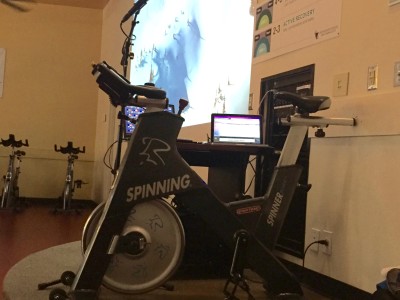The overall concern of any fitness professional should be safety. We must always make every effort to provide a safe environment for those taking our classes. Health clubs and fitness studios a re responsible for providing a safe environment and equipment for their members and staff. As instructors, our responsibility is to ensure that every aspect of our indoor cycling class, from specific training concepts to the use of the bikes, is conducted using safety guidelines.
re responsible for providing a safe environment and equipment for their members and staff. As instructors, our responsibility is to ensure that every aspect of our indoor cycling class, from specific training concepts to the use of the bikes, is conducted using safety guidelines.
Currently, there is a vast amount of discussion in the indoor cycling industry over what truly represents safe practices. On one side of the debate is the “Keep it real” faction. Their side of the safety story is that instructors should not do anything on an inside bike that they would not do on their bicycle. They consider anything outside of their limited movements on the indoor bike as dangerous and harmful to the students. This stance always evokes some debate in itself as there are many movements and riding styles that are done on bicycles that certainly even the boldest of instructors would never attempt on an indoor bike. For example, jumping on mountain and bmx bicycles, hopping over potholes or curbs on a road bicycle and many other necessary elements of outdoor riding that should never make their way into the studio. Generally, the rides from this group of instructors focus on a training objective and the music is considered secondary. This group considers themselves the traditional or pure indoor cycling instructors.
The other side of the debate is held by the “Rhythm” indoor cycling instructors. This group seemingly has a most things go approach to indoor cycling and often their rides include the use of small hand weights, quickly cycling jumps (or tap backs) and other non-traditional movements on the indoor bike. They contend that there is no scientific, or medical, evidence that would suggest that the movements they perform on the indoor bike are actually dangerous or cause injury to the students. Generally, the rides from this group of instructors focus on the music and the dancing on the bike and the clear training objective is considered secondary.
We look at this debate from a wider perspective. As a group exercise professional, we believe that your job is to get people off of the couch and entice them to join in an active lifestyle. We like to take the middle road on teaching styles: all rides should contain sound and clear training principles, but we also realize that music is perhaps the most important aspect of the ride construction. While delivering a quality class that gives the rider”™s results is important, people with not continue to train with you unless the music is something they like and most importantly fits the work being performed in BPM, emotion and intensity.
Please look for the next section of this series for the continued conversation and some safety specifics.
Originally posted 2019-01-05 09:06:39.
- The Weekly Ride – 12/07/18 Last Years Holiday Ride - July 20, 2024
- The Weekly Ride – 04/16/18 Speed and Muscular Endurance - June 23, 2024
- ICI Podcast 0006 – Amy's Race Day Ride - April 12, 2024

